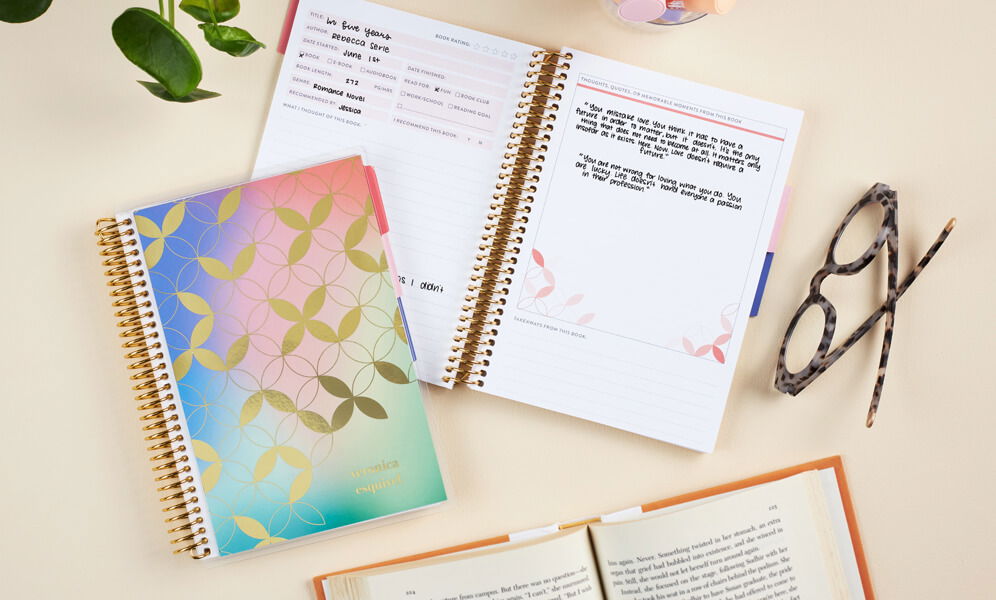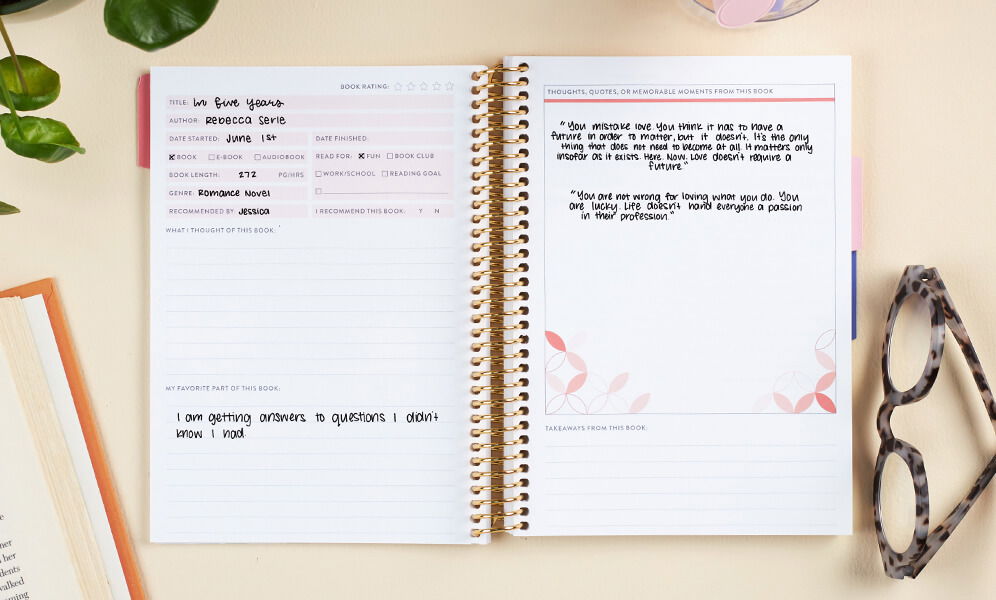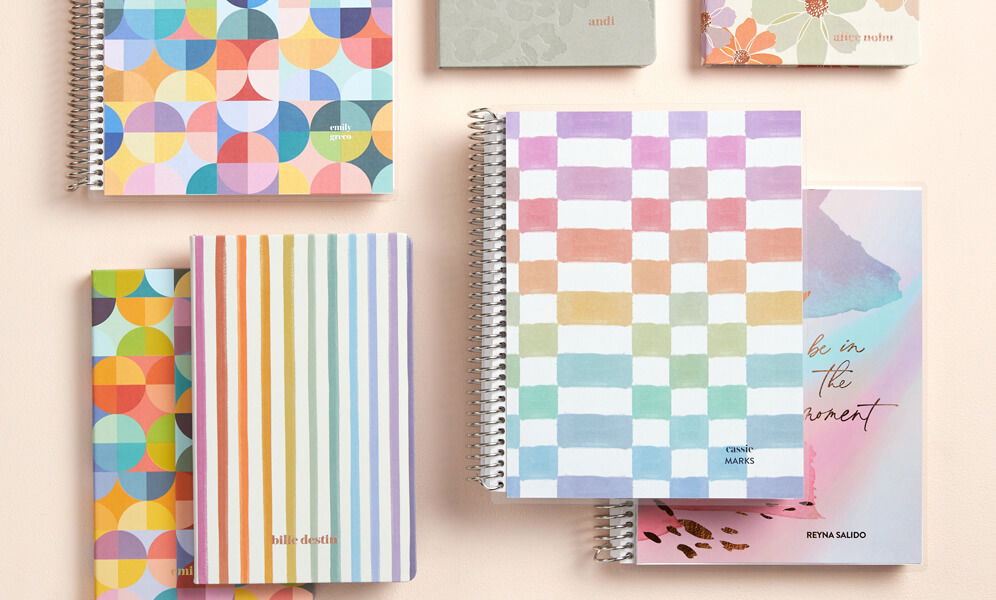15 Reading and Book Journal Ideas to Inspire Your Inner Bookworm

For avid readers and book enthusiasts, a reading journal is more than just a collection of thoughts and notes—it's a personalized sanctuary where the magic of your favorite books comes to life. Whether you're a seasoned journal keeper or new to the world of book journaling, this article will be your guide to unleashing creativity and organization within the pages of your reading haven.
I’m Savannah–a book lover, organization expert, and digital marketer at Erin Condren. I have loved reading for as long as I can remember; I even run my own book club with over 1,300 avid book lovers. Today, I am going to give you all the inside scoop on how to annotate, track reading goals, and start a book journal with ease.
15 Creative Reading and Book Journal Ideas
1. Reading Goal Tracker
Kick off your reading journal with a dedicated section for keeping track of the books you’re reading and set goals for the month and even the year. This checklist in your book tracker helps you set targets for the number of books you want to read in a month or a year and update your progress regularly. You can reflect and recommend books that you read last year in a fun and inspirational way. This visual representation can be a powerful motivator to keep turning those pages but also know that whether you meet your goal or not reading is about having fun. Don’t focus too much on the destination and keep your eyes on the many stories that will take you there.
2. Monthly and Yearly Review Spreads
Create spreads where you can reflect on your reading journey each month and year. Use your book tracker to note down your favorite reads, surprises, and disappointments. It's a great way to see your reading patterns and preferences evolve. Throughout the year I’ll find myself slipping in and out of my reading patterns. Some months I’ll finish up to 10 books and other months I might not even finish one book. Review spreads not only let you log your preferences but they can also help you see why you may not have met your goal for the month. Although I may have only read one book for the entire month it may have been because I was busy with work, family obligations, or a mix of so many things. When you can log this information in a review spread it helps you leave discouragements behind on your reading journey.
3. Doodles, Drawings, and Illustrations
Infuse your reading journal with visual creativity by incorporating doodles, drawings, and illustrations. Use fun and functional stickers to decorate and add a pop of color to your journal. Sketch scenes from your favorite books or express your emotions visually. Let your artistic side complement your literary adventures. I recently reread one of my favorite books from when I was a little girl. There was a scene where the main characters go to a ball. I remember the main female character's dress being so beautiful and when I finally got to that scene I decided to draw it based on the description in my reading journal. Illustrating your favorite outfits, scenes, and characters from the books you’re reading not only gives you a positive creative outlet while you annotate, but it’s a beautiful way to memory log as well.
Related: 30 Art Journal Prompts for Relaxation and Creativity.
4. Upcoming Book Releases
Stay ahead of the literary curve by dedicating a section to upcoming book releases. Jot down release dates, author details, and brief descriptions. A new release book tracker helps keep you excited about what's on the horizon and lets you plan your future reading list. Follow your favorite authors on social media to stay on top of anticipated sequels and new book releases.
5. Books by Genre Bookshelf Spread
Organize your reading journal like a personal library with a bookshelf spread. Categorize books by genre, and add titles as you read them. This not only makes your bullet journal visually appealing but also helps you navigate your collection effortlessly. As a self-proclaimed romance reader, I have to break down my reviews by sub-genre to keep everything organized. When I come back to my review or need to find a title to recommend to someone it makes it a much more organized process.
Explore more with 25 Creative Bullet Journal Page Ideas + Time-Saving Tips.
6. Favorite Quotes Collection
Capture the essence of your favorite books by creating a compilation of noteworthy quotes. Let the words that resonated with you leap off the page and onto your journal, serving as a timeless reminder of the beauty of literature. I often start this process by flipping through my favorite books that I’ve annotated. Journaling and planning accessories are an important part of the process. I will flag pages with sticky tabs and highlight my favorite quotes directly onto the page using all my essential writing tools. This makes my personal library even more special to me but it also makes it easier to transfer my favorite quotes to my reading journal.
7. TBR List
A "To Be Read" (TBR) list is a must-have section in your reading journal. Social media has made my TBR list endless with so many recommendations from authors, booktok creators, celebrities, and friends. There simply aren’t enough hours in the day to read all of these amazing books out there. Make sure to give yourself enough room in this section because the TBR list will truly be never-ending. Note down books you're eager to explore and revisit and revise the list as your reading preferences evolve. It will be a great roadmap for your next reading adventures.
8. Character Analysis and Reflection
Delve deeper into the narratives by conducting character analyses. Reflect on the protagonists, antagonists, and supporting characters. Jot down your impressions, emotions, and how characters evolve throughout the story.
9. Favorite Authors and Their Notable Works
Celebrate your literary heroes by creating a dedicated space for your favorite authors. List their notable works, and update it as you explore more of their writings. This becomes a curated guide for fellow readers.
10. Did Not Finish Log
Not every book captures your heart. Maintain a "Did Not Finish" or DNF log where you can briefly note down the books that didn't resonate with you. It's a valuable record to understand your reading preferences better. Once in a blue moon, you will come across books that you just can’t finish. That’s okay! This DNR book tracker will help you steer clear of authors you may not have loved or genres that just weren’t your style.
11. Reading Challenges
Challenge yourself with various reading prompts and themes. Create a section in your bullet journal to track your progress in reading challenges, such as reading a book from every continent or exploring diverse genres. You can challenge yourself to read from a new cafe each week or to find book recommendations from your favorite celebrity. These little challenges can help get you out of a reading slump or keep your passion for books thriving.
12. Keeping Track of New Words You’re Learning
Enhance your vocabulary by dedicating a section to new words you encounter. Note down the word, its definition, and the book in which you found it. It's a delightful way to watch your language skills grow. Sometimes authors will even include dialogue from other languages! It’s a great way to learn new phrases and better understand the scene you’re reading.
13. Writing About How Books Have Impacted Your Life
Books have the power to shape our perspectives and impact our lives. Dedicate a reflective space in your bullet journal to explore how specific books have influenced your thoughts, actions, or worldview. Even if a book was just your form of escapism for an afternoon then it positively affected your life. While some books might take the grand role of changing your view of the world some may take the small but important role of offering comfort in times that you need it.
14. Literary Bucket List
Create a literary bucket list with books you aspire to read. Whether it's a classic you've always wanted to tackle or a genre you've yet to explore, this list serves as a roadmap for your literary aspirations.
15. Book Reviews and Ratings

End each reading experience with a thoughtful review and rating. Summarize your thoughts, highlight key aspects, and assign a rating. Over time, these reviews become a treasure trove of your reading journey. It’s also an extension of memory tracking. Add your reading start and finish date to each review and watch as your reviews expand over time. If you reread a book you can even compare your original review to your new one, and see if your thoughts or viewpoint changed.
How to Make a Book Journal
Choosing the Right Notebook
Selecting the right notebook is crucial for a satisfying book journal experience. Consider factors like size (from pocket size to A5 size to letter size), paper quality, and binding. Whether you opt for a classic leather-bound journal, a guided journal, or a customizable bullet journal, make sure it aligns with your preferences.

Gathering Your Supplies and Accessories
Enhance your journaling experience by gathering supplies and accessories. Colored pens, markers, highlighters, stickers, and sticky notes can add flair and functionality. Invest in quality pens that won't bleed through pages, ensuring your bullet journal stays neat and legible. You can use these same materials to annotate directly into your book as well. This creates a fun, colorful reading and journaling experience that you’ll be able to look back on and admire.
Setting Up Your Book Journal
Divide your journal into sections based on the ideas mentioned above. Use tabs or page markers for easy navigation. Personalize it further with an index page, cover page, and any other embellishments that resonate with your style. You can color-code for even more organization!
Need more inspiration for starting your new journal? Dig into these fun empty notebook ideas.
Frequently Asked Questions About Keeping a Book Journal
What Is a Reading Journal?
A reading journal is a personal space where readers can document their literary adventures. It typically includes reflections, reviews, reading goals, and creative elements, making it a unique and individualized record of one's reading journey.
What Goes in a Standard Reading Journal Entry?
A standard book tracker or reading journal entry may include the book title, author, date started and finished, a brief summary of the book, personal reflections, your favorite quotes, and a rating. However, the beauty of a reading journal lies in its flexibility—readers can tailor entries to suit their preferences. Make the journal yours, personalize the experience to your reading style, and adapt it as your preferences change.
What Are the Benefits of Keeping a Book Journal?
Keeping a book log offers several benefits, including improved memory retention, enhanced critical thinking skills, and a deeper connection with your favorite books. It’s a great creative outlet It also provides a tangible record of personal growth, reading goals, and evolving reading tastes.
Embark on your reading journal journey with enthusiasm and creativity. Let your bullet journal, custom notebook, or reading log be a reflection of your literary adventures, a canvas for your thoughts, and a testament to the transformative power of books. As you explore these 15 creative ideas, remember that there are no strict rules—let your book journal evolve organically, just like your love for reading. Start your journaling journey today and get all the write stuff, pens, markers, and more, at Erin Condren.